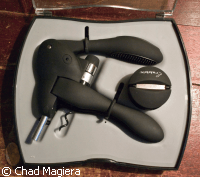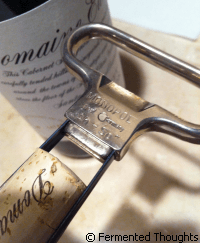Wine lovers should choose their wine opener with care. Not only will it make a statement about your wine sensibilities, it will provide years worth of practical value, or at least, it should. Nowadays, with electric wine openers, Screwpull-designs, Rabbit-designs and the age-old waiter’s friend, a wine lover choices are overwhelming. Each has its beauty and strong points, after we go through them, you should feel confident in finding your next wine opener. Below is a summary of what people consider before buying beyond if the wine opener will work. Different people have different priorities so to be a useful guide to everyone, you need to breakdown.
Wine Opener Comparison | Click Image to Enlarge
- Durability – Will it last and how long? Do you need to replace parts or swap batteries? When it breaks will it also ruin a bottle of wine too?
- Physical Effort Required – How much of the work is done by the wine opener and how much muscle do you have to use?
- Learning Difficulty – Can you do something wrong and destroy the cork? Do you need familiar with this kind of opener before or at least, be careful?
- Portability – Can you fit the wine opener in your pocket or is it better as a household item? Will it recork the wine bottle or provide a cork suitable for re-use?
- Flexibility – Will it work on all corks, from old, decaying ones to synthetic ones to unexpectedly crumbly ones?
- Style – Does it look the part? Will it be a fashion statement in your kitchen or the talk of a wine tasting? Or will it show how unpretentious your love of wine is?
- Cost – Are you interested in an investment or something that gets the job done cheaply? Will it be a source of pride or a tool?
 Waiter’s Friend
Waiter’s Friend
Waiter’s Friend (also called a sommelier’s knife or wine) stands out for being the most portable of wine openers, being small enough to slip in your pocket. It is frequently a tool of pride for servers and sommeliers who have worked in restaurants.
Winged Corkscrew
The winged corkscrew is still around, and although it did not dominate as the household wine opener of choice, a good quality build winged corkscrew can give a wine lover years of satisfaction. With a winged corkscrew, as the worm is snaked into the cork, two levers (handles that look like wings) reach up. Once the worm is thoroughly planted in the cork and the levers are nearly vertical, you pull down both levers at once pulling out the cork in one swift motion.
Even though it takes less work than a waiter’s friend, the cork comes out in one stage, and it can be uncontrolled if you aren’t careful. But beyond being careful and being strong enough to pull the cork out (somewhere between the strength of a child and an adult in their prime), there is not much to learn after you see one used.
The drawbacks for winged corkscrews are they tend to be mediocre at everything. They don’t give you the intimacy or style of a waiter’s friend. At the same time, winged corkscrews aren’t as effortless as the Rabbit design nor as controlled as the similar Screwpull Classic design. And winged corkscrews have a slightly increased risk of shredding. But the main knock on them is their durability. The torture chamber like setup of gears normally doesn’t have sturdy enough make to last year after year. I have personally had a few stainless steels one give way in my hands.
 Rabbit Design (Lever Style)
Rabbit Design (Lever Style)
These once-ugly devices may take the cake for ease of use, short of an electric one or a table mounted one. In fact, the rabbit design wine opener was named after how it looked. But new ones that follow the same principle may or may not look like the original.
A rabbit design corkscrew essentially is a corkscrew that you clamp over the top of a wine bottle (normally using the rabbit ear grip) and then you pull a lever one way (the inserting of the worm mechanism) and push it back the other way to its original position (pulling the cork out). It works by the same system to reinsert the cork.
The big innovation of this system beside reducing everything to one lever is allowing the person opening the bottle to have control off the bottle (through the clamp). With the winged corkscrew you are pressing down on the bottle and the resistance created by the table underneath forces the cork up. No one is actually securing the bottle of wine directly.
The lever style also excels in how by giving the lever a wide range of motion, it decreases the degree of effort needed. So the amount of effort ends up being significantly less. The lever design’s styling has improved and now ones look like they are made out of chrome or are just a lever without any internal works.
Many people swear by these lever designs, and I expect them to soon become the most popular method. If you encounter resistance after some time, you may have to replace the worm.
Screwpull System (original)
The Screwpull Classic brought an amazingly simple innovation. It wraps around the top of a wine bottle in a similar manner as the Winged Corkscrew. And it starts in the same way as you twist the handle inserting the worm. But rather than causing levers to rise as in the Winged Corkscrew, you just keep turning and the cork slips out of the bottle. One motion.
The simplicity of this method is why it is so attractive. I haven’t heard of anyone messing it up yet. The Screwpull type are ideal for picnics or anytime you have to open a wine bottle far from home or help.
In general, they aren’t the prettiest wine opener but they are getting better looking. Most fit nicely in a kitchen drawer. For me, their real allure is their simplicity and providing a practical, almost full-proof opener for a reasonable price.
Just to forewarn you, the Screwpull brand is also used on some Rabbit designs.
The Ah-So
The Ah-So is a very peculiar wine opener composed of two thin metal blades of unequal length that burrow between the cork and the bottle to lift the cork out. By rocking it back and forth, it literally shimmies down around the cork and then shimmies the cork out. The technique is not a trick of magic but is the hardest opener to learn with some practice and oversight needed along the way. Still, it has a very important purpose if not for everyone.
The Ah-So has a loyal oenophile following. This makes sense as in certain circumstances, it is far superior than its competitors. It is known as the butler’s friend because one can remove the cork and taste/test the wine without damaging the cork or seal of the wine. This is crucial for those who are aging wines and for those in the wine making industry. For those with command of the Ah-So, it is the optimum opener for decaying and defectve corks such as from aged bottles. When done right, the trauma to the cork and thus the chance of it shredding is significantly less. Almost always, the weakest part of a cork is on the inside where a corkscrew would be buried not on the rim.
 However, a beginner risks sending the cork into the wine bottle. The Ah-So also requires good motor skills and a bit of patience. It may take a minute to get a difficult cork out. But if you invest a lot into wine and are likely to have a situation where an Ah-So would be the best tool, you should buy a quality one and get it down.
However, a beginner risks sending the cork into the wine bottle. The Ah-So also requires good motor skills and a bit of patience. It may take a minute to get a difficult cork out. But if you invest a lot into wine and are likely to have a situation where an Ah-So would be the best tool, you should buy a quality one and get it down.
Electric Bottle Opener
Electric Bottle Openers do all the work for you. Now they are relatively cheap starting at somewhere around $20. Although there are some complaints for the most part, people are happy with them especially if the wine drinker does not have the strength for a mechanical opener.
In general, the cheaper ones look clunky and may be hard to match the look of your kitchen. They are not exactly the most friendly to bring on a picnic. Also, some models are somewhat loud. One of the main benefits is also one of the main drawbacks. With an electric bottle opener, you do not have control of the cork removal and when the cork is falling apart, it may be dicey to trust an automated process. But they may not have the long life of a quality built wine opener. But in general, quality built waiter’s friends, lever design corkscrews and winged corkscrews are significantly more expensive than the average model.
Table Mounted Wine Opener
The table mounted wine openers have used the same mechanical idea as the rabbit design for longer. It normally has a clamp and a crank like lever. The heavy build is perfect for opening lots and lots of wine bottles, and one expends very little effort. Often they are beautifully ornate and can really be a showpiece in someone’s kitchen.
However, they do not come cheap, and you need counter space as it cannot go in a drawer. With an unlimited budget of course, it would be lovely to have one, if only to look at. It is the antithesis of the waiter’s friend, but surprisingly, you may find that most avid wine lovers tend to gravitate to these extreme different contraptions.
The table above gives the average performance of that type of wine opener in any particular category. Some fair much better than the average. And do a little research as the better ones are necessarily more expensive. Please share your experience in the comments!
See our article on buying wine glasses!
Creative Commons Photos from Flickr
